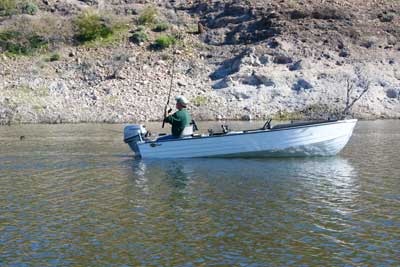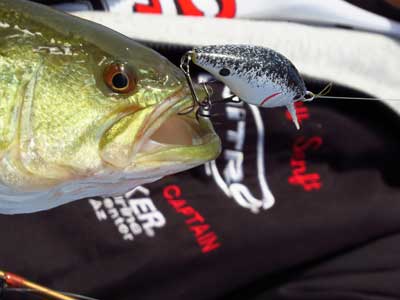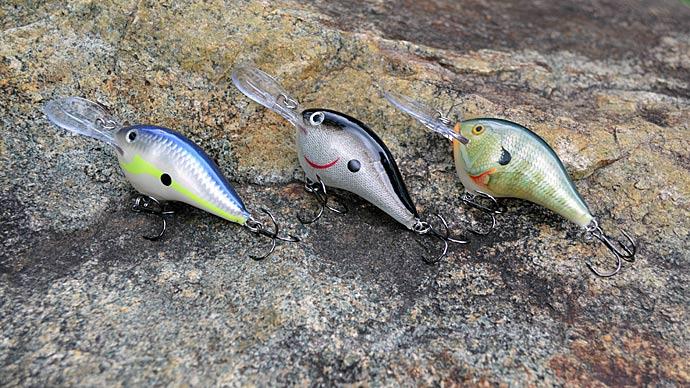
Gas prices being what they are, many of us are considering switching to a smaller boat or even a kayak, so we can continue to enjoy our favorite sport. Sometimes we might want to walk the bank of a quarry or a pond where a boat is impossible or forbidden. Usually, the first question that springs to mind is, "How will I carry all my equipment?". But relax – it's not that big a deal. After all, plenty of guys fish from shore and carry all their gear!
Bass Fishing Basics First
Years ago (decades, actually), I was fortunate enough to attend a seminar by one of Arizona's most legendary bass anglers – Art Price. Art always preached simplifying your bass fishing by focusing on the basics, and that’s something a lot of us can benefit from. I’ll be the first to admit that I probably have WAY too much stuff in my lockers.
In a way, carrying less "stuff" makes fishing a lot easier. Back in the day, when our boat was a 12-foot rowboat with a nine-horsepower Merc on it, we caught tons of fish and rarely changed baits. Nowadays, I sometimes switch baits every fifteen minutes – am I giving those lures enough time for a judgment?
You will have to carry less gear if you’re downsizing to a smaller boat, fishing as a non-boater, walking the bank, or even getting a kayak. The trick is knowing what is essential – and Art was the king of preaching essentials.
Gear Basics
You need one good 6-1/2 to 7-foot medium-heavy baitcasting rod and reel spooled up with 12-pound test line. This rod will let you fish jigs, worms, spinnerbaits, large crankbaits, spoons, and other baits. It doesn't have to be an expensive rod and reel, either. There is plenty of dynamite and affordable combos available at any sporting goods store near you. You might even be able to buy a pricey brand-name outfit from a fishing friend or a local pro who is thinning his gear.

Check places like Craig's List, Buy Nothing groups on Facebook, yard sales, and more when you're in the market for a rod and reel. You might be shocked at what you can find. If you fish tournaments, keep your ears open for anybody who might be selling off some of their gear. Estate sales are excellent, too. Watch the ads or call to see if they have any fishing gear available.
Art says you’ll also need one 6-1/2 to 7-foot spinning rod and reel spooled with 8-pound-test line. This rig will allow you to throw lighter baits like Ned rigs, small swimbaits, tubes, small cranks, small swimming jigs, split-shot, and drop-shot rigs. But, again, you can save a lot of money by shopping around for sales or good used equipment.
If you already have a lot of rods and reels, then to downsize to a smaller boat or kayak, bring one baitcaster and one spinning rod with you. Seriously, that's all you need. The last thing you need in a small boat or kayak is a heap of rods getting tangled up and in the way.
Bass Tackle Basics
According to Art, all a bass fisherman needs is one small tackle box with ten lures. Yup – just ten lures. You'll be prepared to fish every water column level effectively with these ten lures. Art always warned against the "magic lure" syndrome, where fishermen fall for every new gimmick. He said that's like looking for the Fountain of Youth, and you're likely to find them simultaneously!
The Ten Lures You Need:
- Smoke/glitter jigs in 3/8 and ½ ounce
- 4-inch or 6-inch Westy Worms (Nowadays, this would mean finesse worms, preferably floaters, on a light jighead with a gold hook that bends easily.)
- Shad colored crankbait
- Crawdad colored crankbait
- Chartreuse spinnerbait
- White spinnerbait
- Purple worms, 6-inch
- Chartreuse and black 4-inch ringworms
- Smoke/glitter lizards (Zoom sexy shad)
- Surface lure – chugger or walking bait
I find it amazing that these baits are still some of the most popular bass baits, even after all these years. They flat-catch fish. You'll need 3/16- and ½-ounce slip sinkers for rigging Texas rigs, plus 2/0 and 3/0 hooks. He also suggests bringing ½-ounce jig heads for worms, lizards, and other baits.
You might want to have a depth finder and marker buoys when fishing from a boat.
Basic Fishing Structure

Points are prominent fishing structures – they hold fish almost any time of year since fish use them to go from deep to shallow water. Art says for fishing points, use your jigs, Westy Worms, crankbait, and surface lures. You might use just one or a combination of these baits to fish different areas of the point or at different times of the day. But it's possible to cover a point thoroughly with just these primary baits.
The backs of coves can be fished effectively with spinnerbaits, surface lures, and Texas-rigged worms. Depending on the time of day and year, you'll probably find the most effective one, but it can change during the day. The beauty of simplifying your tackle is that instead of endlessly changing colors or shapes, your limited tackle forces you to change lures altogether, which is often the key to getting bit.
Rocky cliffs are another critical area for Art. These steep areas are incredibly productive in summer and winter when fish like to hang out in deep water in places where it's easy to see baitfish above and get to them quickly. Art's favorite lures for bluffs and cliffs are jigs, Westy Worms, and surface lures. Instead of Westy Worms, try your small worms or lizards on light jigs.
Windy or breezy banks and brush lines are perfect areas for reaction baits like crankbaits and spinnerbaits. Wind and waves stir up things that baitfish like to eat, and the bass follow the baitfish, while weed and brush lines are ideal ambush spots for bass waiting to snap up a passing meal. A reaction bait makes the bass choose it or lose it, and they often choose to grab it.
Submerged structure like reefs or rocks with fifteen or more feet of water over them are classic reservoir bass fishing sites. Hopping or dragging a Texas-rigged worm or a jig on these humps and rock piles is excellent for catching big bass.
Art’s Technique Basics for Bass Fishing
- JIGS: work jigs slowly on the bottom and crank-set on anything that feels spongy. Pull the rod to the side and reel quickly while sweeping. Keep the line taut, so you don't give the bass any leverage to throw the bait.
- WESTY WORMS/WORMS ON SMALL JIGHEADS: Work them slowly on the bottom. If you're fishing down a bank, make small hops. When the line goes slack, reel up until it's taut. If you feel pressure, reel quickly to set the hook and keep the fish coming to you. You can pull steadily to straighten out the fine hook and then re-cast if you get snagged.
- CRANKBAITS: Work nearly parallel to the shore, across points, or between bushes with a medium retrieve. Stop and go now and then to give it an erratic motion. Set the hook by sweeping the rod to the side and reeling hard.
- SPINNERBAITS: Cast beyond bushes or rocks or other cover. Retrieve just fast enough to make the blades spin.
- TEXAS-RIGGED WORMS AND LIZARDS: Cast beyond or right into brushy areas and retrieve by using the rod tip to pull the lure from branch to branch. Set the hook hard by snapping the rod up and back while reeling as fast as possible to keep the line taut. Don't let the fish get back into the brush if you can help it.
- SURFACE LURES: Work with a chug and pause movement very close to cover. Use a crankset when you get bit and keep the line taut.
Art’s final piece of advice for bass fishermen: Simplify your fishing by learning the basics first!
Whether you're just getting started in bass fishing and money is tight, downsizing, or planning a walkabout fishing trip, these basics should help you catch bass just about anywhere. No matter how long you've been fishing or how much stuff you have, sometimes it pays to get back to basics.
BassResource may receive a portion of revenues if you make a purchase using a link above.




